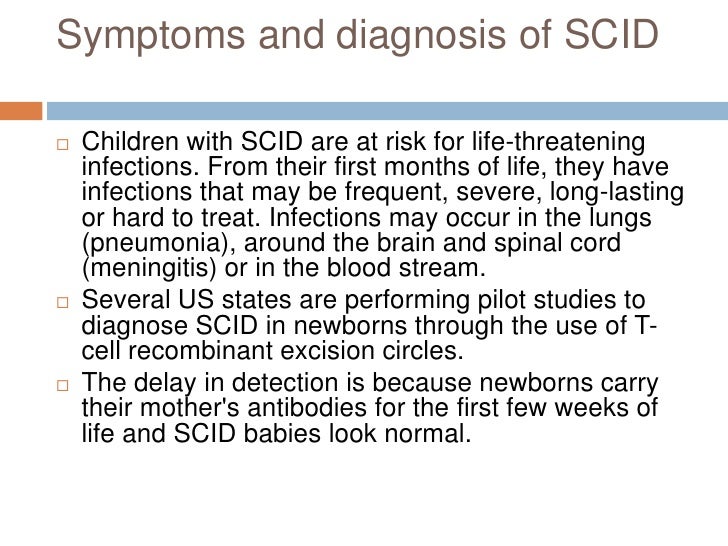

For infants in which a bone-marrow transplant is not completely successful, or for those who are not candidates for a bone-marrow transplant, administration of proteins to help the immune system function may be beneficial. If you can cure the foal of one infection, any number of other bacteria, viruses, and other infectious organisms can still infect. Approximately 90% of infants can be successfully treated with a bone-marrow transplant. This test can also reveal carriers of the gene so as to allow horse owners to prevent two carriers from breeding, which increase the chances of producing an SCID foal. The only treatments for SCID are bone marrow transplants from healthy people, ideally a matched sibling the unaffected cells can then repopulate the immune system of the baby with SCID. X-SCID is almost universally fatal unless a successful bone-marrow transplantation or gene therapy is completed. What is the prognosis for an individual with X-Linked Severe Combined Immunodeficiency? SCID due to adenosine deaminase (ADA) deficiency. Gene therapy may also be considered for patients that are not good candidates for bone-marrow or cord blood transplantation. Therefore, SCID can be cured with hematopoietic stem cell transplantation, and in some cases, gene therapy. Cord blood transplantation may also be an effective treatment of X-SCID.

Bone-marrow transplantation has a significantly higher success rate if performed shortly after birth. Replacement of the bone marrow in a person with X-SCID with the bone marrow of a healthy individual allows the body to generate new, functional blood cells and lymphocytes. How is X-Linked Severe Combined Immunodeficiency treated?īone-marrow transplantation is the most common form of treatment for X-SCID. More information about the true incidence of the condition may come as other countries adopt newborn screening and registries become more established. X-SCID occurs at a similar frequency amongst all ethnicities, but X-SCID may be more prevalent in the United States due to population structure. It is thought to occur in at least 1 in 50,000 to 1 in 100,000 male births. How common is X-Linked Severe Combined Immunodeficiency?

Babies with an atypical form of X-SCID may have immune-system dysfunction, rashes, gastrointestinal problems, and short stature. They may also have absent tonsils and lymph nodes. Most infants with untreated X-SCID will show slower than average growth, develop significant diaper and oral rashes, and will have severe, persistent infections despite active treatment. Symptoms of X-SCID typically begin between three and six months of age. However, there are rare cases reports of female carriers affected by X-SCID. Jude Children’s Research Hospital cured infants born with so-called Bubble Boy disease generated coverage from the likes of The Washington Post and ABC News, not. T he announcement Wednesday that gene therapy developed at St. Because of this, men with a harmful change in IL2RG are affected by X-SCID, while most female carriers still have one working copy of the gene and do not tend to show symptoms. Jude announces gene therapy cure for babies with X-linked severe combined immunodeficiency. Without the enzyme, immune cells are not able to fight infections. Males have one copy of the X chromosome and the IL2RG gene, while females have two copies. Adenosine deaminase-deficient severe combined immunodeficiency, also known as ADA-SCID or bubble baby disease, is caused by a genetic mutation that results in the lack of the adenosine deaminase enzyme, which is an important component of the immune system. X-SCID is an X-linked disease which means that the IL2RG gene is on the X chromosome. Since the immune system is unable to function properly, individuals with X-SCID are unable to fight off infections. These individuals also have B lymphocytes that do no work. Individuals with X-SCID are missing two important immune-system components, T lymphocytes and natural killer lymphocytes. The IL2RG gene gives our bodies instructions for making part of a protein called the common gamma chain, which helps our immune system function.
#SCID CURED SKIN#
X-linked severe combined immunodeficiency (X-SCID), caused by harmful genetic changes (mutations) in the IL2RG gene, is a disorder of the immune system that causes recurrent, severe infections, fevers, and skin rashes. What is X-Linked Severe Combined Immunodeficiency?


 0 kommentar(er)
0 kommentar(er)
